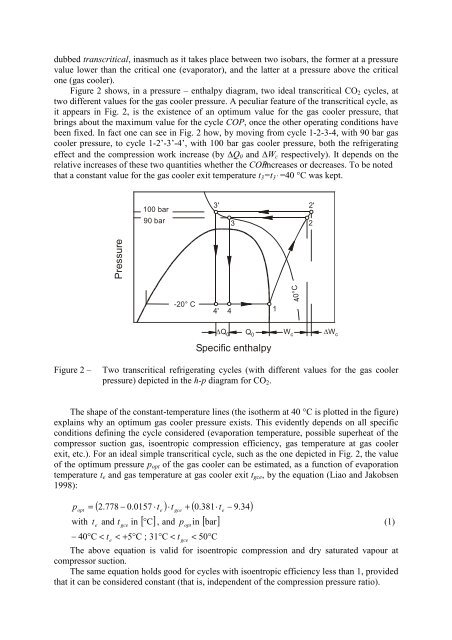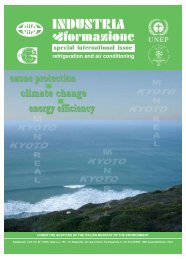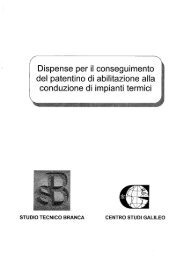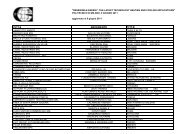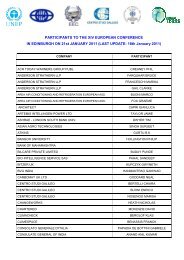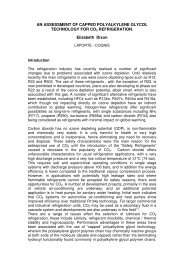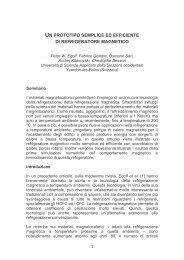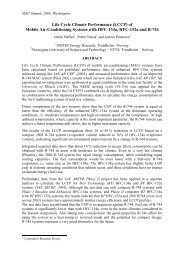PROPERTIES OF CO2 AS A REFRIGERANT - Centro Studi Galileo
PROPERTIES OF CO2 AS A REFRIGERANT - Centro Studi Galileo
PROPERTIES OF CO2 AS A REFRIGERANT - Centro Studi Galileo
Create successful ePaper yourself
Turn your PDF publications into a flip-book with our unique Google optimized e-Paper software.
dubbed transcritical, inasmuch as it takes place between two isobars, the former at a pressure<br />
value lower than the critical one (evaporator), and the latter at a pressure above the critical<br />
one (gas cooler).<br />
Figure 2 shows, in a pressure – enthalpy diagram, two ideal transcritical CO 2 cycles, at<br />
two different values for the gas cooler pressure. A peculiar feature of the transcritical cycle, as<br />
it appears in Fig. 2, is the existence of an optimum value for the gas cooler pressure, that<br />
brings about the maximum value for the cycle COP, once the other operating conditions have<br />
been fixed. In fact one can see in Fig. 2 how, by moving from cycle 1-2-3-4, with 90 bar gas<br />
cooler pressure, to cycle 1-2’-3’-4’, with 100 bar gas cooler pressure, both the refrigerating<br />
effect and the compression work increase (by Q 0 and W c respectively). It depends on the<br />
relative increases of these two quantities whether the COPincreases or decreases. To be noted<br />
that a constant value for the gas cooler exit temperature t 3 =t 3’ =40 °C was kept.<br />
100 bar<br />
90 bar<br />
3'<br />
3<br />
2'<br />
2<br />
Pressure<br />
40°C<br />
-20° C<br />
4'<br />
4 1<br />
Q 0<br />
Q 0<br />
Specific enthalpy<br />
W c<br />
W c<br />
Figure 2 –<br />
Two transcritical refrigerating cycles (with different values for the gas cooler<br />
pressure) depicted in the h-p diagram for CO 2 .<br />
The shape of the constant-temperature lines (the isotherm at 40 °C is plotted in the figure)<br />
explains why an optimum gas cooler pressure exists. This evidently depends on all specific<br />
conditions defining the cycle considered (evaporation temperature, possible superheat of the<br />
compressor suction gas, isoentropic compression efficiency, gas temperature at gas cooler<br />
exit, etc.). For an ideal simple transcritical cycle, such as the one depicted in Fig. 2, the value<br />
of the optimum pressure p opt of the gas cooler can be estimated, as a function of evaporation<br />
temperature t e and gas temperature at gas cooler exit t gce , by the equation (Liao and Jakobsen<br />
1998):<br />
p<br />
opt<br />
with<br />
=<br />
t<br />
( 2.778 0.0157 te<br />
) t<br />
gce<br />
+ ( 0.381<br />
te<br />
9.34)<br />
and t in [ ° C] , and p in [ bar]<br />
e<br />
gce<br />
opt<br />
40°<br />
C < te<br />
< + 5°<br />
C ; 31°<br />
C < t<br />
gce<br />
< 50°<br />
C<br />
The above equation is valid for isoentropic compression and dry saturated vapour at<br />
compressor suction.<br />
The same equation holds good for cycles with isoentropic efficiency less than 1, provided<br />
that it can be considered constant (that is, independent of the compression pressure ratio).<br />
(1)


